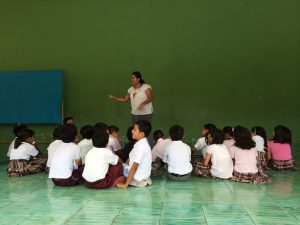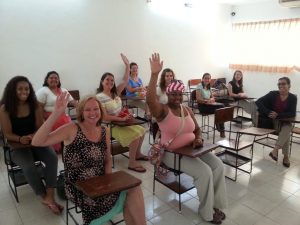Mexico Study Tour Helps NC Public School Teachers Bring Global Dimension to Classroom
July 31, 2017
UNC Global Affairs
In the three years since a group of teachers traveled to Mexico’s Yucatan Peninsula to learn about a different education system and broaden their perspectives, they and their K-12 students are still reaping the benefits.
Betty Brandt Rouse, an English as a second language (ESL) teacher at Creekside Elementary School in Durham, recently reflected on a Mexico Study Tour she and fellow teachers took in 2014. “We were able to [talk] with teachers in Mexico and learn a lot about how their school system differs from our school system,” she said, “and to get to actually see it and be there hands-on. It was a really powerful experience.”
Rouse was one of eight North Carolina public school teachers who participated in the Mexico Study Tour organized by the Consortium in Latin American and Caribbean Studies, a collaboration between the University of North Carolina at Chapel Hill Institute for the Study of the Americas and Duke University Center for Latin American and Caribbean Studies.
Participants attended a series of pre-trip workshops to prepare them for the experience. Once in Mexico, they spent nine days meeting with Mexican educators, visiting schools and historic sites, and engaging in multicultural experiences such as homestays and cooking classes.
Emily Chávez, outreach program coordinator for the consortium, designed and led the study tour with assistance from the site coordinator, Mariana Domínguez.

“I wanted the teachers to better understand their role as North Carolina teachers within a global context—and to understand that our lives and our privileges in the U.S. are inevitably intertwined with the people of Latin America and Mexico in particular,” explained Chávez. “I wanted the teachers to have a variety of experiences that got them thinking about the role of history, the role of political power, who shapes education, and what it means and what it takes to retain Maya culture and language within and outside Maya communities.”
One aspect of the program was creating new curriculum to implement in the classroom. Nicole Emmert, teacher librarian and school testing coordinator at Oak Lane Elementary School in Hurdle Mills, incorporated aspects of Maya culture and art into library studies. She’s installed art from around the world and has created exploratory centers and clubs based on the culture and ideas of other countries.
“I have maps and globes everywhere in the library for students to study and explore,” Emmert said. “They are more interested in other countries and ways of life now. Students are less intimidated about the idea of travel.”
Rouse brought back artifacts from her time in Mexico that she incorporates into her lessons—instruments, Maya toys and games, indigenous clothing, money and children’s books written in Mayan and English.
“The big point of the unit was students being able to tell how their lives are similar and different from kids’ lives in Mexico,” Rouse said. “One part was about sports, and one was including Maya literature…we took [that] compare-and-contrast and turned that into a literacy unit.”

By adding these multicultural components to her lessons, through pictures and other objects, and drawing on her experiences abroad, Rouse is better able to connect to students in her ESL classes. Rouse has traveled to several of the places her students are from, including Mexico, Guatemala and parts of Africa. Experiencing different cultures has helped her become more accepting of difference, particularly in the classroom.
“Being able to get out of your little bubble and being able to be in and see another place and another perspective is very beneficial for teachers,” Rouse said. “The more you understand parts of the world, the more you realize how many different ways there are to do something, and the fewer assumptions you have for each of your students…You begin to see that there is a different story behind each person.”
Emmert agrees that these life lessons were an invaluable part of the Mexico Study Tour experience.
“I’m more laid back now, and I know that teaching life and social skills is just as important—if not more so, actually—as teaching curriculum,” Emmert said. “I’ve learned to take time to listen and learn from everyone you meet.”
“The Mexico Study Tour is one way the Consortium has worked with the K-12 community to strengthen and add depth to the way North Carolinians learn and teach about Latin America and Latin American communities,” explained Beatriz Riefkohl Muñiz, executive director of the Institute for the Study of the Americas. “The combination of UNC and Duke’s scholarly expertise in the region and the immersive nature of the visit makes the tour a particularly effective learning tool for educators.
The Mexico Study Tour was made possible with funding from the U.S. Department of Education Title VI program for National Resource Centers.
